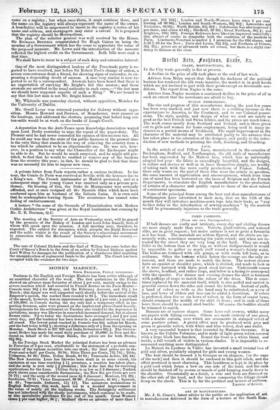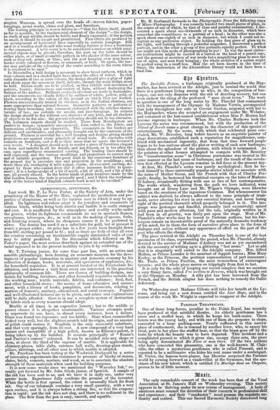ART IN MANUF ACTURES.
Mr. J. G. Crace's latest advice to the public on the application of art in manufactures delivered in the form of a lecture at the South Mar
sington Museum, is spread over the heads of—woven fabrics, paper- hangings, metal works, china and glass, and furniture.
The leading principle in woven fabrics is—" that the fabric itself, should as far as possible, be the fundamental element of the design "—the design, in duffs of any solidity should be boldly and firmly expressed ; if the pattern be small, it should be simple and geometrical. Fine effects are produced by an arrangement of horizontal lines especially in curtain hangings. Silk used in a woollen stuff should take some leading feature or form a boundary to the ornament. A table cover is to be considered a surface on which orna- mental objects may be placed ; therefore, the part on the table should be either plain, or of small geometric pattern in two shades of the same colour, such as deep red, green, or blue ; and the part hanging over may have a border richly coloured of flowers, or ornament, or both. Or again, the bor- der may partake of the colouring of the centre according to the room where it is required to be used."
In Brocatelles a bold design is necessary to show broad surfaces, which in deep colours and in a shaded light have almost the effect of velvet. In rich satin damasks of two or more colours, the design should give a play of light and shade upon the ornament itself, delicate, though the main design must be bold. Indian stuffs are to be studied, as they exhibit rich invention of pattern, beauty, distinctness and variety of form, without destroying the flatness of the surface. Brilliant contrasts of colour are made to harmonize, and the ornaments are clearly defined by outlines of white, yellow, gold, or black, according to the colour of the ground on which they are worked. Flowers conventionally treated in chintzes, as in the Indian chintzes, are more appropriate than natural flowers. Geometric patterns or patterns of flowing lines branching into ornament elaborated with the stitches charac- teristic of lace, are suitable for muslin and lace-hangings. In carpets the design should be flat without cast shadows of any kind, and all shadows of objects to be flat also : the general colouring should not be too obtrusive. The Aubusson carpets should be studied. Those from Masulipatam are perfect in design ; symmetric arrangement, form suited to the fabric, and harmonious colouring are observable. The ornaments on the borders are delicate and unobtrusive, and pleasantly brought out by the contrasts of the ground. Flatness is essential for a wall hanging and designs giving shaded projections are against every principle of sound taste. He concludes with remarks on furniture, and so fit is their sense that we quote the lecturer's own words. "A designer should seek to render a piece of furniture elegant in form and tasteful in all its details, and not depend, as is too often the case, upon superfluous ornamental carving. The leading lines should be well expressed, and the various mouldings and projections in correct style and of suitable proportion. The great fault in the commoner furniture of the present day is excessive size and projection in the mouldings ; and, worse than all, overlaying it with vulgar, coarse, ill-executed carving, de- signed by those who cannot draw (for it offers immense facility to ignor- ance); it is a hodge-podgo of a bit of scroll, a bit of shell, and a bit of foli- age, all grossly abused. In the better kinds of plain furniture made by the first London houses, the taste is generally good ; and I think the workman- ship of the better kind of English cabinet-work is not to be excelled."



































 Previous page
Previous page